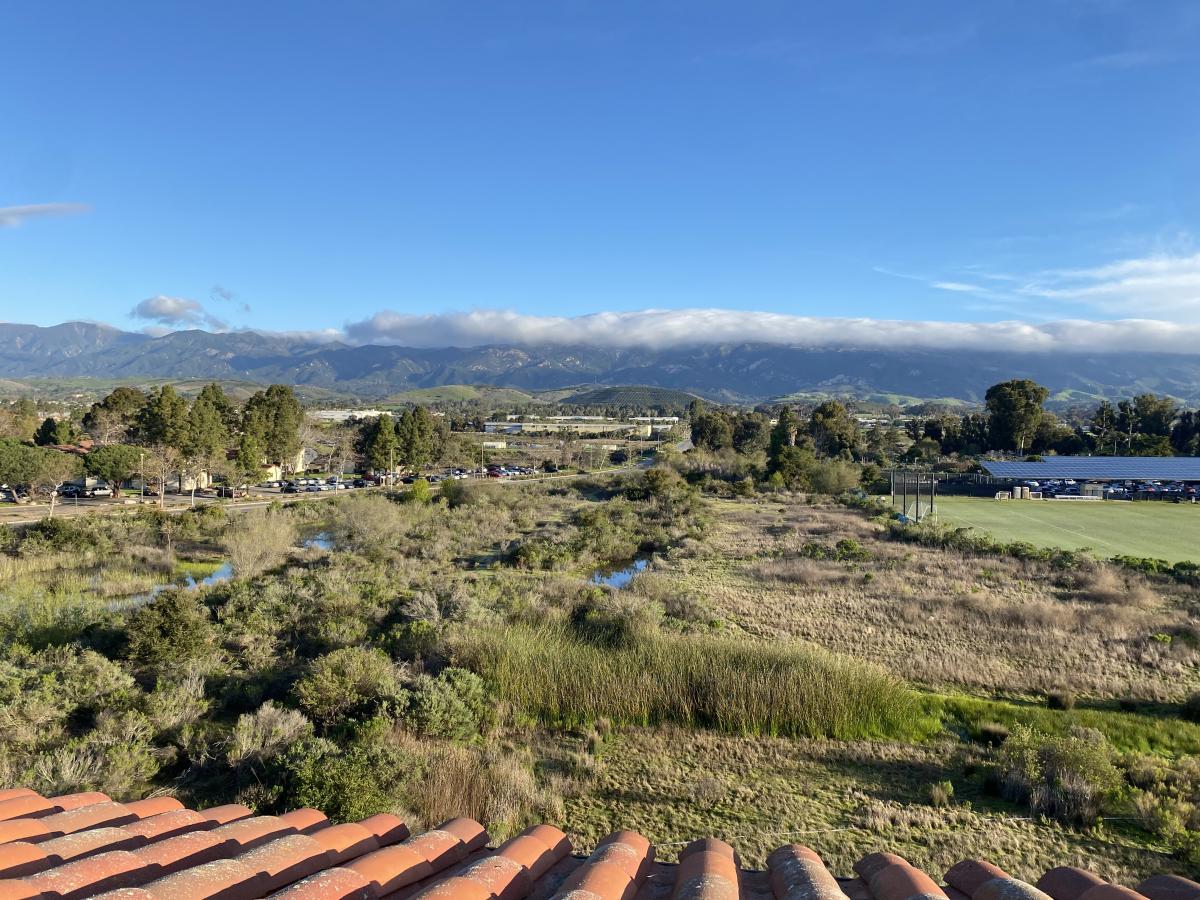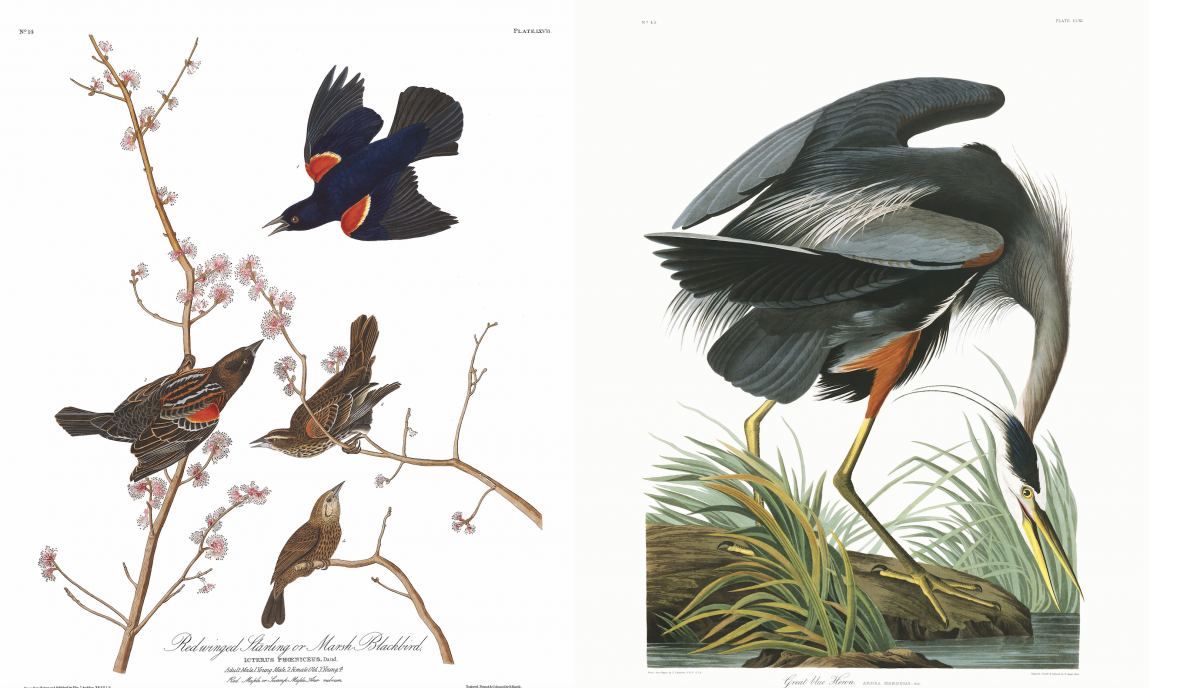 Red-shouldered hawk perched on the Residence rooftop
Red-shouldered hawk perched on the Residence rooftop
Credit: Maksym Serbyn
Over the last seven years that the Charles T. Munger Physics Residence has been housing KITP’s visiting researchers, an unexpected member of the community has become a local celebrity among the building’s staff and guests. With deep brown eyes and a blanket of feathers that glow a rusty-red color in the sunlight, the beloved red-shouldered hawk is a bird found commonly in the area. While they typically nest in oak, pine and eucalyptus trees, these hawks have made quite the impression by making regular appearances on the balconies and rooftops of the Residence. They seem to show little concern about attracting attention, sometimes even putting on a show for lucky passersby. One quiet afternoon, for instance, staff were walking along the patio when a flapping noise caught their attention. Within seconds, one of the resident hawks quickly swooped down only a few yards in front of them, then took off with a thin, black snake wriggling and writhing between its sharp beak. Serendipitous encounters like these have turned the red-shouldered hawk into one symbol of the natural beauty visitors can find just steps away from their rooms.
When guests look north towards the Santa Ynez Mountains, they have a picturesque view of protected wetlands, chaparral, and grasslands situated between UCSB’s Storke Field and Los Carneros Road. This region is a small portion of coastal land that was historically inhabited by the Chumash Indigenous Peoples for thousands of years.
 Northern view from the Residence
Northern view from the Residence
Credit: Demi Cain
Today, the approximately six-acre stretch of land constitutes the San Clemente Habitat Restoration Site, which is one of several projects undertaken by UCSB’s Cheadle Center for Biodiversity and Ecological Restoration. The Cheadle Center manages over 340 acres of open spaces surrounding UCSB, leads restoration and conservation projects, and maintains collections of local plant and animal species used for biodiversity research. The San Clemente site was established in 2005 to mitigate the impacts of the adjacent San Clemente Villages housing development for UCSB graduate students. This site is one of several restoration efforts associated with campus housing including Manzanita Villages, Sierra Madre, San Joaquin and Ocean Walk.
Prior to 2005, the San Clemente site consisted of existing wetlands and was dominated by non-native grasses and some native plant species. The most notable native plant whose protection was an important factor in establishing the project is the Southern tarplant. Though the species doesn’t have state or federal protection status, the California Native Plant Society (CNPS) classifies it as a plant considered rare, threatened, or endangered in California and elsewhere.
 Southern tarplant
Southern tarplant
Credit: Calflora.org / Eric Koberle
Another hallmark of the San Clemente site is its stormwater management system, which captures and filters 100% of the stormwater runoff from the San Clemente housing complex. The system is made up of multiple bioswales and a one-acre vernal marsh dedicated to collecting stormwater and is full of native sedges, rushes, and other wetland species. The water is filtered through plants and soils that remove pollutants—a process called biofiltration—and then it hydrates the surrounding landscape.
The restoration of San Clemente was an extensive project that took five years to construct. The land was first carefully graded to support the flow pattern of stormwater as it moves throughout the wetlands, and to support adequate basins to hold the water for biofiltration. This resulted in a rolling landscape similar to the natural conditions found in an undisturbed wetland. After grading was completed in 2006, various erosion control tools like netting, dams, and other materials were installed to prevent sedimentation of the site’s hydrological features and the nearby Storke Wetland and Goleta Slough.
 Before and after images of the San Clemente Restoration site
Before and after images of the San Clemente Restoration site
Credit: The Cheadle Center
 Blue eyed grass (left) and owl’s clover (right)
Blue eyed grass (left) and owl’s clover (right)
Credit: The Cheadle Center
The next step in restoration was large-scale weeding to reduce the abundance of non-native plants and create better conditions for native species to thrive. By focusing on the removal of non-natives that compete with native species, less revegetation was needed. Now, more than 100 native plant species thrive in the San Clemente site alone. Trees like coast live oak, Western sycamore, and black cottonwood were some of the project’s first plantings because they take the longest to mature, and are now part of the visual landscape our visitors enjoy. Flowering plants also visible are the California poppy, blue eyed grass, red maids, California fuchsia, owl’s clover, sacred datura, bush sunflower, and many other species that produce beautiful blooms.
Visitors may also be fortunate enough to see the variety of animal species that frequent the site. In addition to the red-shouldered hawks, there are birds like California scrub jays, Western bluebirds, great blue herons, Anna’s hummingbirds, red-winged blackbirds, killdeer and lesser goldfinches, among a multitude of others. In fact, illustrations of a number of these birds by John James Audubon adorn the walls of the Residence’s Kaplan Dining Room. Other wildlife belonging to the area are Pacific chorus frogs, monarch butterflies, common buckeyes, alligator lizards, western skinks, and brush rabbits, to name a few.
 National Audubon Society
National Audubon Society
Lisa Stratton, the Cheadle Center’s Director of Ecosystem Management, leads the team that maintains the site on a regular basis through hand weeding and removing larger shrubs to keep open habitats and reduce the risk of fires. Much of the bulrush that takes over the wetlands is mowed down every other year to allow for more water and new plant growth—which is “a big operation,” according to Stratton. Restoration sites like San Clemente help the Cheadle Center carry out an important part of its mission, which is offering classes and internships to train UCSB students in ecological restoration and gain experience in field research. At the Munger Residence, scientists and their families are encouraged to read the recently installed signage looking out onto the patio or watch for friendly hawks and other animals while on the outdoor playground. It is a special opportunity for residents and guests in the San Clemente Villages and Munger Physics Residence to stay so close to this compact hub that provides habitat to wildlife, protects native plant populations, and showcases some of this region’s abundant biodiversity.
by Demi Cain
KITP Development Coordinator
